Hyla CE-5 Review – Rhythm over Melody

Pros –
Hyper-engaging with terrific control, Very spacious stage, Great end to end extension
Cons –
Driver flex, Nozzle doesn’t hold tips well, Not especially realistic in timbre
Verdict –
The CE-5 suits buyers searching for a sound that is unique without compromising ergonomics or resolving power.
Introduction –
You probably haven’t heard of Hyla but maybe you’ve read into the success of PWAudio and Oriolus. Neither company possess the greatest market presence in the west, but they have a very loyal fan base and a development/manufacturing process backed by the much larger Cyras; and all the budget and resources associated. As a result, Oriolus have quickly made a name for themselves through their resolving in-ears. Their earphones aren’t an assembly of generic components, but are meticulously engineered in-house, essentially, from the ground up.
And within this, Hyla represent a step forward using the technologies pioneered by Oriolus. They’re a little more experimental, a little more daring and a lot more intriguing. The CE-5 embodies this ethos, utilising a quad hybrid driver setup with a single dynamic woofer, 2 Sonion midrange drivers and a ceramic super tweeter. The result is an earphone that sounds as unique as its specifications would suggest. It should be noted that the CE-5 is a limited run earphone with only 200-units worldwide, it retails for $832 USD. You can read more about the CE-5’s “Trident Engine’ here and secure a unit for yourself here.
Disclaimer –
I would like to thank Hyla very much for providing me with the CE-5 for the purpose of review. All words are my own and there is no monetary incentive for a positive review. Despite receiving the earphones free of cost, I will attempt to be as objective as possible in my evaluation.
Accessories –
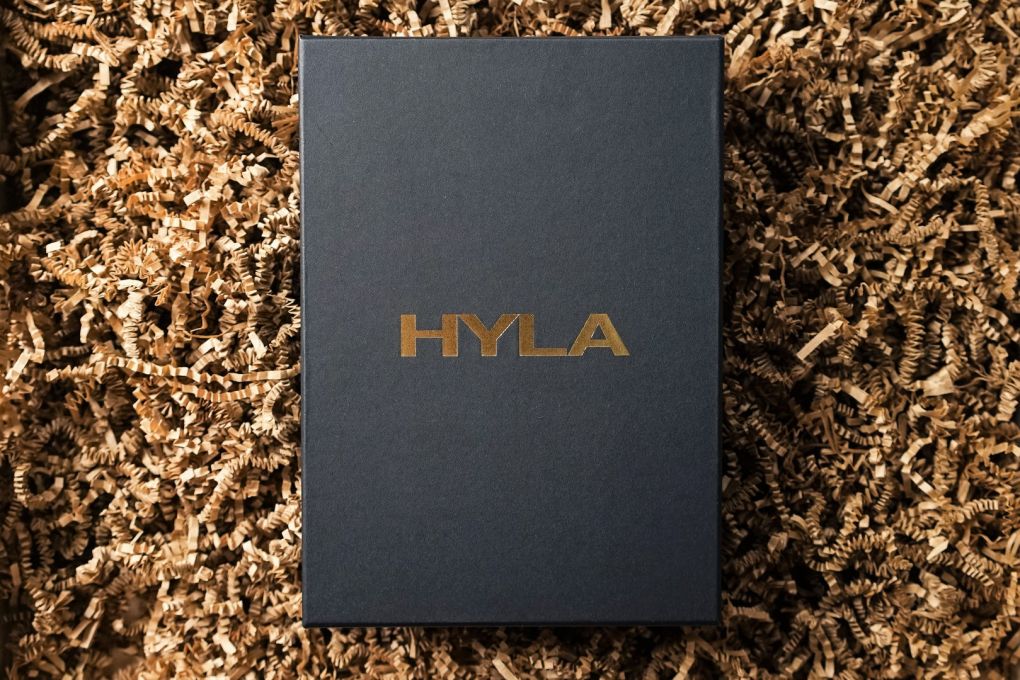
The CE-5 comes in a minimal hard box with gold Hyla text providing a hint of the premium goods inside. Upon opening the box, the buyer is greeted by the CE-5 and one of Van-Nuy’s legendary cases decorated in silken fabric.

The case contains a selection of ear tips in addition to a cleaning tool. Hyla provide 3 sizes of silicone tips in addition to a pair of dual flanges. The CE-5 also comes packaged with 3 pairs of foam tips that provide increased isolation and a more personalised fit.
Design & Build –
Unique adequately defines Hyla’s CE-5; not because of any precious materials, but by nature of their design. With sharp, teardrop-shaped housings and a very intriguing purple colour scheme, the CE-5 draws the eye akin to an exotic hyper-car. The earphones may not employ metal in their construction, but they’re 3D printed from German resin and finished to the standard of jewellery. Furthermore, the CE-5 employs titanium sound tubes to reduce resonances.

Resultantly, the earphones feel as pristine as a mass-manufactured product and look as fascinating as a jewel. The CE-5 is quite large, with fairly squared off corners on top, but it carries itself well in the ear. This is mainly due to the terrific sculpting of their housings, with a thin tapered front end and rounded rear. I did find the edge at the back to form a small hotspot after several hours of listening, but this is a surprisingly ergonomic earphone for its size.
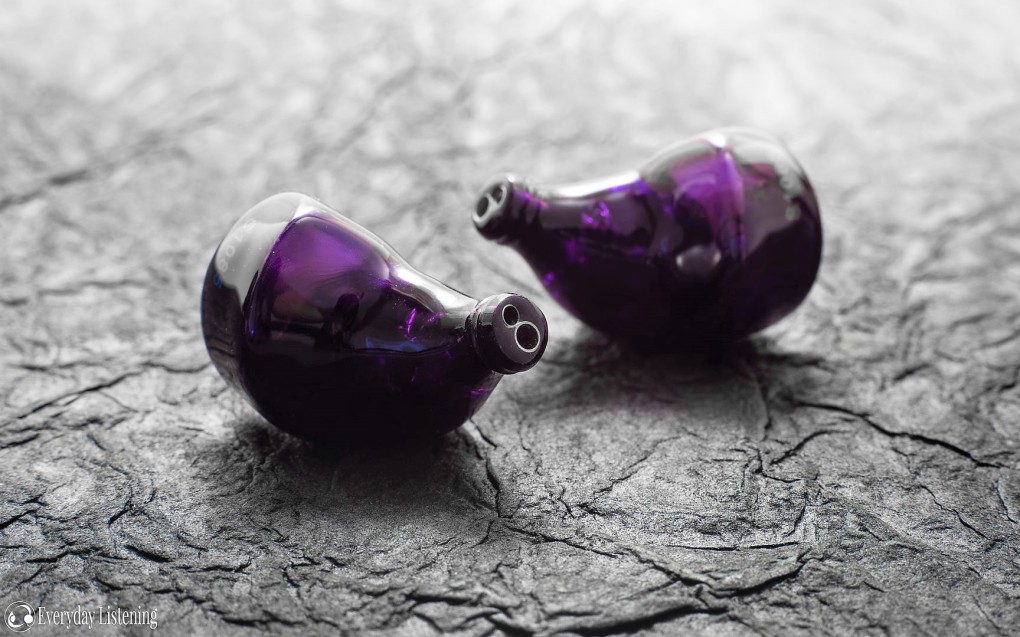
And, once fit, the Hyla remains very stable in the ear due to a combination of their over-ear design and tapered, elongated sound tubes that provide a very deep fit. The nozzles have no filters, but there are internal filters protecting the drivers themselves. The nozzles also have some slight ridging but I didn’t find them to hold tips especially well.
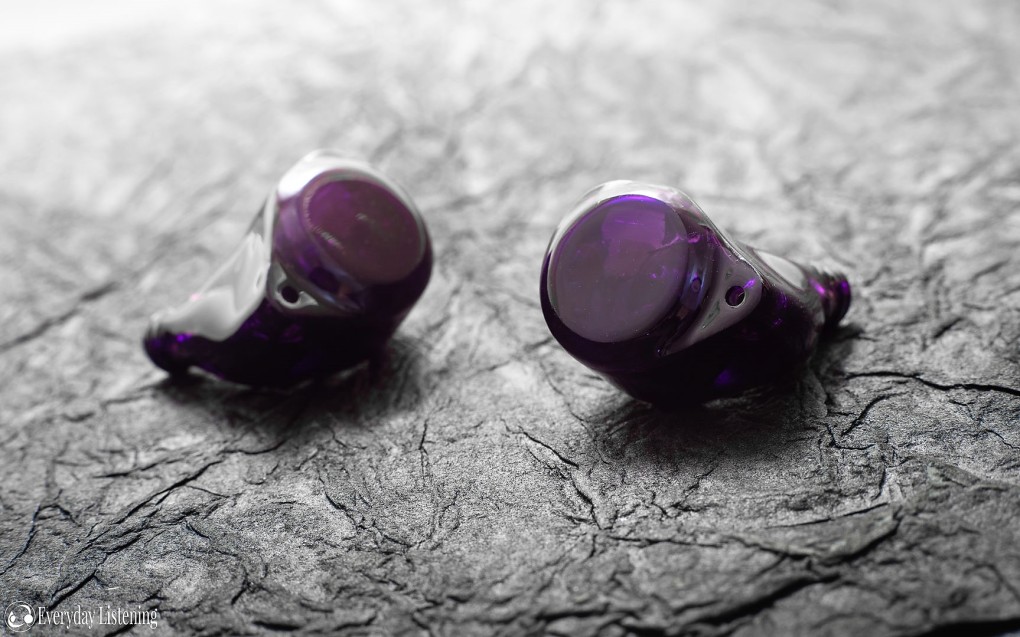
The earphones have a small vent on their outer face but still produce very high levels of noise isolation despite their vented design. They don’t attenuate quite as much as a fully sealed monitor from Campfire for instance, but they’re easily adequate for anything from commute to air travel. Some driver flex is present when first inserting the earphones, but I haven’t experienced damage or degradation of sound quality during my month of testing.

Up top, is a recessed 0.78mm 2-pin removable cable system. Unfortunately, Hyla isn’t using the glorious PW No.5 of the Japanese Oriolus MKII, but the included cable houses premium 6N OFC copper innards. It’s otherwise a fairly standard 4-core braid with memory wire guides that hold their position well and provide some additional fit stability. The cable itself has a smooth texture and a supple in-hand feel. I didn’t experience any intermittency and the right angle 3.5mm plug has excellent strain relief.
Sound –
Tonality –
The CE-5 has a modest v-shaped signature on account of its emphasized sub-bass and lower-treble. This isn’t a reference earphone by any stretch of the imagination. Rather, the CE-5 was intentionally designed to chase engagement and energy. It also isn’t the most linear or realistic earphone, but the CE-5 remains one of the most impressive V-shaped earphones I’ve heard.
In particular, its recessed but well-separated midrange and detail forward presentation perfectly complement the more vocal forward mastering style of Japanese albums without over-brightening the high-end. Moreover, the CE-5 has plenty of technicality to flatter other music too. I gave the CE-5 200hrs of burn-in to ensure optimal performance during final evaluation, more in the following sections.
Bass –
The CE-5’s bass presentation is big and bold yet presented with meticulous controlled. And, as sub-bass is the main focus of emphasis, it doesn’t overly colour other aspects of its sound. Sub-bass extends to the deepest depths of human perception, with powerful emphasis producing visceral rumble and slam. Mid-bass is less flavoured with a smaller lift infusing tasteful warmth and body into the CE-5’s low-end. And, as is fairly typical of bassy but clear in-ears, its mid-bass feeds into a relatively attenuated upper bass response intended to increase separation between bass and mids, minimising colouration.
What makes the CE-5 a unique earphone then, is the quality of that low-end. Of course, hints of bloat is present by nature of their tuning but muddiness is kept minimal as a result of the CE-5’s excellent transience and control. The CE-5 is incredibly tight and agile without a hint of sloppiness, even during faster tracks. And, as notes have slightly shorter decay, bass remains well separated and very defined despite uneven emphasis. The CE-5 thus excels through a combination of physical slam and impact combined with enhanced articulation; they aren’t balanced, but execute their bassy sound with technical mastery.
Mids –
The Hyla’s midrange is bright and clear yet impressively neutral in tone. Both male and female vocals occupy a slightly distant stage position while instruments are brought more to the fore through the earphone’s aggressive, V-shaped signature. Still, by combining increased mid-bass warmth with reduced lower-midrange density, the earphones produce nicely transparent vocals and instruments even if both can lack a little body. Still, The CE-5’s lower midrange has plenty of fullness to engage and to achieve a natural presentation while capitalising on increased clarity and separation.

Upper mids are subjectively less influenced by the CE-5’s bass colouration, delivering smooth and extended if laid-back female vocals. Midrange resolution is terrific, compounding upon a brighter signature to grant great clarity without the associated unnatural raspiness or sibilance. Upper mids also possess relatively neutral body and tone, though background layers can sound a little thin as a result of increased emphasis on articulation. Resultantly, the CE-5 is a lively yet clean in-ear focussing on clarity and detail over linearity and timbre. They aren’t quite as resolving of background details as more natural, linear in-ears, but do provide a very revealing sound focussing on transparency and resolution.
Highs –
Through emphasized yet well-integrated lower-treble set to a more attenuated middle-treble, the CE-5 delivers a treble presentation that boasts pristine attack while maintaining a dark, clean background. Some may find them a little hot, but the Hyla’s aggression brings intricacies to the fore with great detail and crispness permeating throughout its presentation. And, due to the relatively gradual nature of its emphasis, the CE-5 doesn’t sound overly thin or peaky, though they aren’t especially natural either. Their reduced middle treble may not sound ideal, as it saps some air and shimmer from their sound. However, in the context of the CE-5’s signature, this style of tuning works wonders, creating a treble presentation that remains composed and controlled despite its energy.
Moreover, treble is incredibly well extended with upper-treble extending linearly into the highest registers. This contributes to the earphone’s very high resolution that enables great detail-retrieval despite its uneven signature. Lower-treble elements such as high-hats do sound slightly tizzy due to emphasis on upper harmonics, but notes are very clear and wholly resolved. Moreover, strings, though aggressively detailed, can be a little forward at times. That said, decay is only slightly short and every note is accurately textured. These traits produce a sound that is resolving and clear if lacking some smoothness and accuracy.
Soundstage –
The CE-5 has a huge soundstage that extends well beyond the head; not on account of enhanced air, but due to its slightly more laid-back midrange presentation and excellent treble extension. And though not especially linear, layers are very well delineated, perhaps to the extent that the CE-5 misses some intermediate density. However, as a result, instruments are very easy to locate and vocals remain well-centred. Due to the agility of the Hyla’s sound, they also produce precise directional cues. Their larger low-end isn’t conducive towards a separated sound, however, the CE-5 actually achieves high levels of separation due to its clearly layered sound. Again, this isn’t an earphone that strives for realism, but rather an earphone whose meticulous sculpting provides overall coherence.
Driveability –
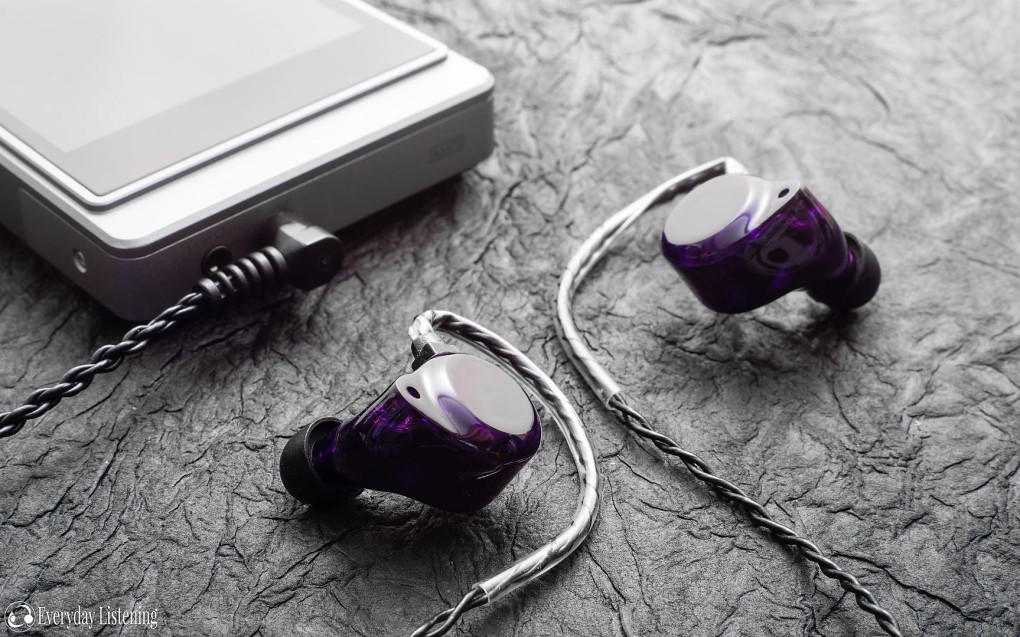
The CE-5 has a very low 8.9ohm impedance combined with an average 97dB sensitivity. In use, it’s a fairly sensitive in-ear but also one that is very obviously affected by output impedance. From a source of higher Impedance, the CE-5 can sound considerably bassier which compromises its transparency and clarity. So though it easily attains higher listening volumes, even from smartphones, the CE-5 definitely benefits from a resolving source with a low output impedance.
iPod Touch 6G: Nicely balanced, tight low-end but lacking some extension. Mids are slightly brought forward though sibilance is also emphasized. Treble is extended and detailed but thin, middle-treble is more present producing greater air and separation. Soundstage is more intimate and less layered, but imaging is sound. No audible hiss detected.
Echobox Explorer: Huge bass, somewhat overwhelming. Mids are more recessed by comparison but smooth and naturally bodied. Reduced clarity and transparency. Highs are detailed, takes some edge off the CE-5’s lower-midrange while retaining crispness. Lacking the extension of other DAPs, its stage is quite spacious but not well separated or organised. Easily audible hiss on low-gain. Unspecified output impedance, it is likely quite high.
Hiby R6: Considerably larger bass, a bit bloomy. Mids are recessed but clear, lacking some transparency. Highs sound a little blunted but still extend nicely. A lot smoother overall and quite bass dominated, stage dimensions suffer as do staging properties; imaging is ok but separation is notably reduced. No hiss detected on low-gain. Significant signature change is likely a result of higher output impedance of 10ohms.
Fiio X7 II w/AM3A: The Fiio is ever so slightly engaging, otherwise, it’s a solid reference source. The Hyla has a tight low-end with a little less body. Mids are slightly recessed but very clear. Highs are extended and very detailed with a little extra edge. The X7 II has a more intimate stage relative to some other DAPs, it isn’t as immersive as the iBasso combo. No hiss detected on low-gain.
iBasso DX200 w/AMP5: Excellent synergy, this amp module has a slightly mid-centric signature with a smoother high-end that perfectly complements the Hyla. The CE-5 sounds more balanced, very controlled and with excellent resolution. The DX200 offers a very large soundstage with improved layering and imaging, heaps of detail. No hiss detected on low-gain.
Cables –
The stock cable is a respectable 6N OFC copper unit though there’s always room for improvement. Given that the CE-5 is a highly resolving in-ear, I was curious to put this into effect! Of course, this is just my subjective impression, take it with a grain of salt.
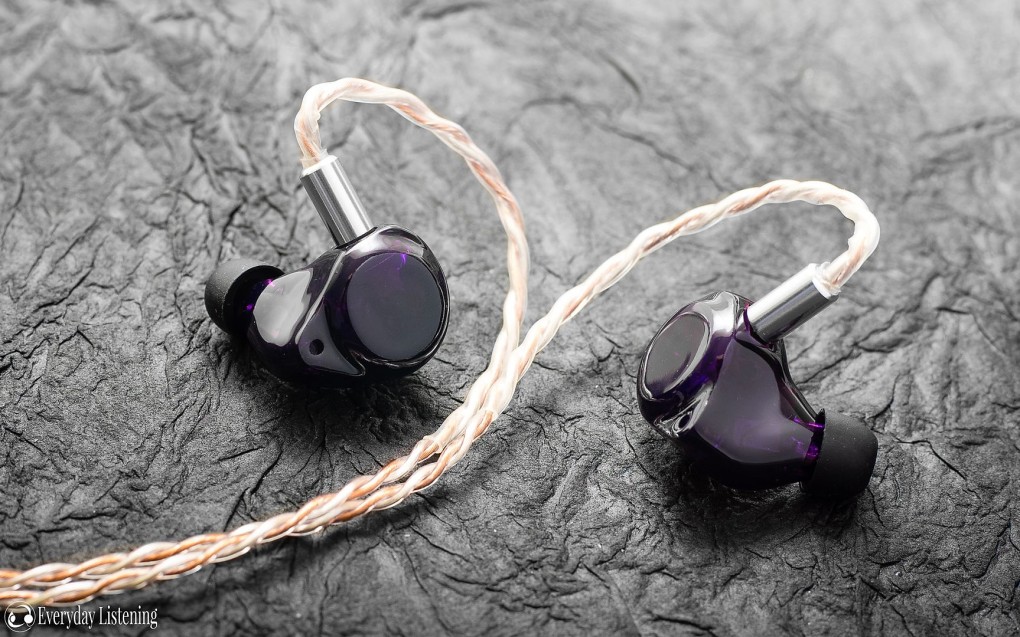
Effect Audio EROS II: Introducing the Eros II into the mix produced numerous changes. Bass became tighter and more articulate while retaining its impact. Mids received a notable benefit, sounding even clearer with a more liquid smoothness. I didn’t enjoy the impact of the cable on male vocals, that became a little thin and strained, but upper mids were supremely smooth and layered; perhaps this character can be attributed to the EROS II’s higher resolution and extension. Highs also received some benefits, becoming more detailed, especially with regards to micro-detail. The cable granted a slightly brighter signature overall, which does sap some of the cleanliness from the CE-5, but also aids air and separation. I didn’t notice any expansion in the CE-5’s stage, but imaging did improve a fair amount, especially with regards to midrange layering.
PWAudio No.5: The No.5 intrigues as Cyras have very close ties to PWAudio, with Japanese Oriolus earphones including this cable from factory. Unsurprisingly, the CE-5, cut from the same cloth, has great synergy with this cable. Down low, the No.5 evens emphasis between sub and mid-bass, while increasing control and definition. Mids become slightly Fuller and more natural, sounding more neutral in body and accurate in timbre. Highs are also granted greater linearity, smoothing lower-treble and increasing its body while slightly increasing middle treble air. The result is a more balanced, natural and spacious presentation with greater control, the No.5 is an almost perfect compliment.
Comparisons –

Dunu DK-3001 ($550): I love the way the DK-3001 sounds, it’s one of the best hybrids of the recent year. It is cheaper than the Hyla, but from glancing at its stainless steel build a gap in quality isn’t apparent. However, in the ear, the much larger CE-5 actually finds higher levels of comfort and much-improved isolation. Both have removable cables, MMCX on the Dunu and 2-pin on the Hyla.
The DK-3001 is more balanced, u-shaped rather than V-shaped, but it has emphasis in similar regions. The CE-5 provides a more visceral sub-bass response with both greater extension and emphasis. The Dunu has greater mid-bass presence and remains emphasized within its upper-bass, producing a warmer, fuller-bodied midrange. The Hyla is a lot more dynamic and less bloated, it has greater definition as a result. Mids are more present on the Dunu and more realistic in timbre due to greater linearity. However, the Hyla is more transparent due to reduced bass colouration where the Dunu sounds warmer and less separated. Both are brighter earphones with an emphasis on articulation due to a similar lower-treble emphasis.
I find the Dunu to layer slightly better due to its more balanced sound, however, the Hyla has greater clarity, resolution and separation; it is the more revealing earphone. The Hyla has a stronger lower-treble emphasis and less middle-treble air than the Dunu. However, though the Dunu is very well detailed, the Hyla retrieves greater foreground detail in addition to being more aggressive in its presentation. The Hyla sounds darker and cleaner than the Dunu due to the weighting of its emphasis’ where the Dunu has greater shimmer. Both extend very well, but the Hyla has more detail at the very top. The Hyla provides a much larger, more separated stage while the Dunu has better instrument placement due to its greater linearity.
Campfire Jupiter ($799): Campfire draw eyes like few others with their aluminium clad earphones, and the Jupiter is one of their most striking designs yet. Though exotic and unique, the Hyla doesn’t feel as premium in the hand. However, in the ear, both are similarly comfortable and the Hyla isolates almost as well as the Jupiter despite being vented. The Jupiter includes one of ALO’s SPC Litz cables which is subjectively superior to Hyla’s included unit in both sound and ergonomics.
The Jupiter is far more balanced but also warmer and mellower in its presentation. The Jupiter has terrific bass-extension for a BA earphone but it can’t match the hybrid CE-5. Bass is unsurprisingly a lot more present on the Hyla, most notably sub-bass but also mid-bass by a hair. On the contrary, the Jupiter has a notable upper-bass hump that imbues warmth and body into its midrange but also a boxiness to its bass notes. On the contrary, the Hyla is more transparent with greater clarity. The Hyla is noticeably brighter where the Jupiter is fairly linear though its midrange. Resultantly, the Jupiter has excellent layering and background detail retrieval that the Hyla can’t match, but it also sounds quite mellow due to its smoother lower-treble tuning.
The Hyla is quite the opposite, with recessed upper-bass and emphasized lower-treble. As a result, it has greater upper-midrange extension and a grander, if less nuanced stage. The Hyla has greater lower-treble emphasis while the Jupiter smooths off before a modest middle-treble lift. As such, the Hyla is more aggressively detailed with a darker background while the Jupiter has more air and shimmer. Both extend terrifically, the Jupiter a little more granting it higher resolution. Both also have terrific soundstages, the Jupiter is more coherent while the Hyla is more spacious. The Jupiter has better resolution through its intermediate layers where the Hyla transitions more jarringly between foreground and background details.
Campfire Lyra II ($699): The Lyra II carries Campfire’s dynamic driver design that is compact and smoothly formed. Its liquid metal construction feels more premium than the Hyla however, the CE-5 isolates a little more and is more stable for my ears. Both have removable cables, once again, I do prefer ALO’s Litz wire on the Lyra II.
The Lyra II is a mellower earphone than the CE-5, pursuing a gentle l-shaped signature as opposed to the more v-shaped Hyla. Sub-bass extension is excellent on both, the Lyra II has a warmer bass presentation on behalf of its greater mid and upper-bass emphasis. The CE-5, therefore, presents notes with greater slam and definition where the Lyra II has a little bloat. The Lyra II has a little more lower-midrange presence but upper mids are similarly laid-back. The Hyla has a little more midrange articulation, its bass response is more separated from its midrange creating clearer and more transparent vocals.
On the contrary, the Lyra II is natural and full-bodied, it isn’t as clear but doesn’t sound remotely veiled either. The Lyra II has a slight lower-treble emphasis that imbues some additional energy into its sound. The CE-5 is clearly more aggressive but the Lyra II is also very well detailed. The CE-5 has greater treble extension and air where the Lyra II sounds even darker, lacking some air and shimmer. As such, the Hyla has greater resolution and its stage is quite a bit larger. I also feel that the CE-5 has more accurate imaging and separation is higher.
Sennheiser ie800S ($999): The ie800 was among the first 4-digit IEMs and the S represents its re-imagining for the present day. Its minuscule matte ceramic housings offer flawless comfort but only modest levels of isolation and stability. On the contrary, the Hyla locks more solidly into the ear and offers more useable levels of isolation. The ie800S has a semi-removable cable that detaches at the y-split where the Hyla is fully removable, utilising the widely adopted 2-pin interface.
The ie800 is more u-shaped as opposed to the clearly v-shaped Hyla; it’s certainly engaging but still reasonably balanced. Sub-bass is slightly emphasized on the ie800 but not nearly as much as the Hyla, nor does it extend as far. The ie800 remains quite linear through its bass, with an impressively even emphasis throughout. The CE-5 is similarly defined and just as controlled despite its larger emphasis. The Senn has a more present midrange though they are still on the laid-back side. As a result of its more linear low-end, the ie800S’ mids are slightly warm but also very natural, more so than the Hyla. Both are very transparent in-ears, the Hyla is brighter with greater clarity and articulation. However, the ie800S is more realistic and coherent with better layering.
Treble is more aggressive on the Hyla with the ie800S demonstrating a more subtle approach. The ie800S still has some additional lower-treble crispness and a middle/upper-treble lift that enhances air. As such, it isn’t quite as clean sounding as the CE-5, but sounds more expansive at the same time. Both extend terrifically well, the Hyla has a small advantage up top where the ie800S is a little peaky, sounding slightly thin. Both have excellent resolution as a result, the Hyla more evidently so on behalf of its clearer sound. The CE-5 has the more spacious stage, mainly due to its laid-back midrange presentation. However, the Sennheiser is more coherent, especially within its midrange with superior imaging. The Hyla has greater separation.
Verdict –
There’s been a bad attitude permeating throughout audio recently; an idea that generic parts in a fancy package can draw a crowd, make money. My experiences in Japan revealed quite the opposite, these are companies fuelled by passion and an insatiable hunger for high-quality audio; even if that means designing proprietary drivers that extend treble beyond human hearing or including expensive cables that provide no measurable impact on frequency response. It’s a refreshing outlook and one that produces innovation with a profound impact on the end product.

Because, I can’t confirm whether that ultrasound ceramic driver aids soundstage dimension and I can’t quantify the impact of the CE-5’s 6N OFC cable or titanium innards. However, what I can hear, is an incredibly engaging V-shaped signature with outstanding technical ability. It’s soundstage is huge, its bass agile and controlled. Mids may not be realistic in timbre, but I would be lying if I claimed they weren’t pleasing to the ear. When listening through the CE-5 from Hyla, one doesn’t monitor audio, they experience music. The CE-5 therefore best suits buyers searching for a sound that is unique without compromising ergonomics or resolving power.
The CE-5 can be purchased from Hyla’s website here for $832 USD. I am not affiliated with Hyla and receive no earnings from purchases through this link.


5 thoughts on “Hyla CE-5 Review – Rhythm over Melody” Leave a comment ›